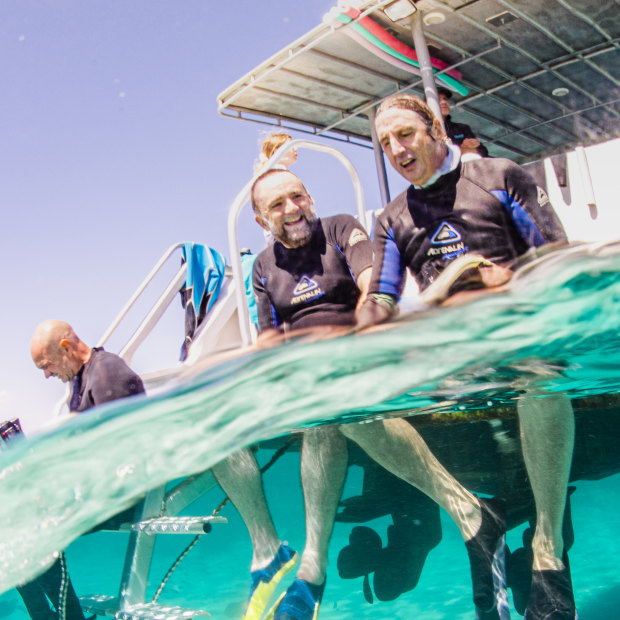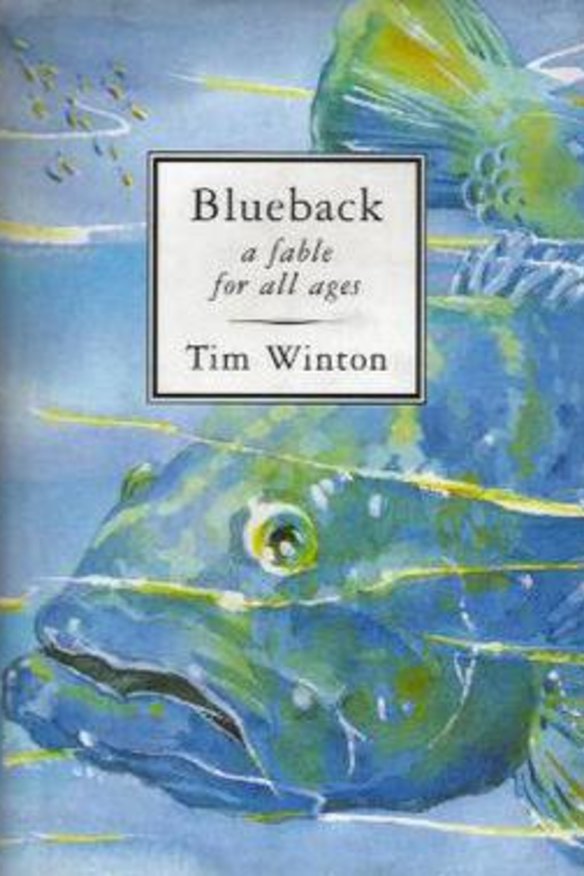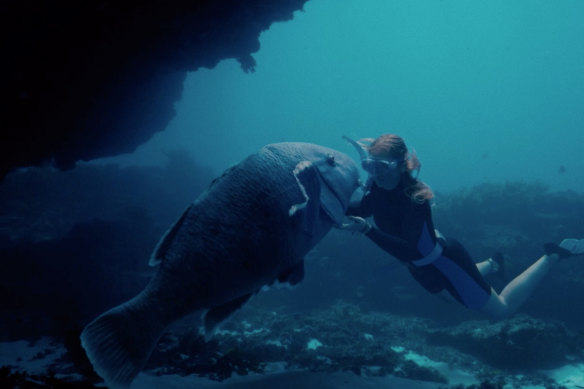This was published 2 years ago
Tim Winton on a blue groper, a novel – and his life-imitates-art moment
Watching your precious novel adapted to the big screen is always fraught. But in the case of Blueback, it reminds this renowned Australian writer just how much his love of the sea has evolved – and what he’s prepared to do to protect it.
By Tim Winton

From left: cinematographer Rick Rifici, director Robert Connolly and Tim Winton on location at Ningaloo Reef, where most of the underwater work for Blueback was filmed. Credit: Vee@BlueMediaExmouth
My first look at Robert Connolly’s film adaptation of Blueback, the little novel I published in 1997, was a private screening, so I took the tribe. It’s rare for me to mix work and clan like this, but the book occupies an unusual place in my life and in our family. Also, Robert’s an accomplished producer and director – Balibo, The Dry and an audacious version of my book The Turning – so I figured we were in safe hands, and thought it might be fun for us to see it together. But as four generations of us filed into the lobby of the little cinema, I was suddenly conscious of the passage of time this gathering represented.
The book is about a family’s special relationship with nature, in the form of a giant fish, the groper whose name became the title. When I wrote it, my kids were children. Now here they were, with their own kids in tow. Back in the 1990s, my parents were in spry middle age. Today they needed to be helped upstairs and settled gingerly into their seats by my nieces and nephews, who weren’t even born when the book came out.
Having your work reviewed is like standing by politely as a stranger rifles through your belongings. Seeing adaptations is less dreadful, it’s true, but not much less. As I waited white-knuckled for the lights to dim, I began to wonder if this tribal screening had been such a good idea.
Robert’s interest in Blueback stretches back 20 years. Any time I mentioned the prospect of this adaptation, people would invariably ask the same question: “How will they get the fish right?” Because a blue groper is not the sort of creature you can train for the movies.
Initially, Robert assumed his movie would need to be an animation. Which made sense. But here we were, about to see a live-action film. After I’d prepped everyone with the news that the title role would be played by a puppet, my granddaughter said: “But, Timmy, you can’t make a puppet swim in real water!”
Well, it turns out that you can. And beautifully. The puppet, let me say, is a triumph.
But Blueback is not a tale about a fish. It’s about a woman. A courageous and determined widow called Dora Jackson. She’s the moral centre of the story. Yes, there’s a big fish in it. A kid, too. But, essentially, it’s a story about Dora’s battle to save her home place from greedy developers. Her ideals and actions challenge and inspire her child from infancy into middle age. So, for me, it’s about a hero.

“It slipped out whole. Fully formed. Like a shark or a newborn child, it was swimming before it was born.” Winton wrote Blueback in a week; it was first published in 1997.
“We come from water,” says Dora, “we belong to it.”
When I first wrote that line, it arrived with a strange jolt of recognition. Now I can see why. I must have got it from Rachel Carson, the American marine biologist and writer, and one of my heroes. She’s best known for her 1962 landmark Silent Spring, but her grand classic is the 1951 book The Sea Around Us. Carson called the ocean “the great mother of life”.
And she’s right. We’re all children of the sea. Not simply because of our evolutionary origins, but because our fate is inextricably linked to the fortunes of the sea: when it dies, so do we.
I wrote Blueback in a week. It slipped out whole. Fully formed. Like a shark or a newborn child, it was swimming before it was born. And it’s never been out of print. In writing it, I knew I was reaching back to the child I’d once been, the awestruck boy for whom the world was still enchanted. But now I see I was also reaching forward, to the man I was yet to become. Because I’ve been swimming in that book’s wake ever since. It changed the shape of my life.
When I wrote Blueback, I was painfully aware that the sea around us had become much sicker and poorer since Rachel Carson’s day. Our mother, the sea, had become our mine and our toilet. I felt a sense of impending doom at its plight. But I never did anything about it. Changing things felt like someone else’s job.
So I wrote my little story. And that was that. On to the next thing. But Dora Jackson haunted me. And held me to account somehow. Which is an odd experience to have: being shirtfronted by a figment of your own imagination.
I felt a sense of impending doom at its plight. But I never did anything about it. Changing things felt like someone else’s job.
Many of us experience the natural world as little more than a backdrop to our lives. We’ve reduced landscapes and ecosystems to settings and locations. Creatures within them are mere objects.
But not for Dora. To her, it’s a subject, a character, the most consequential player in her drama. So when she says she belongs to the sea, Dora’s suggesting more than a moment’s appreciation. She’s talking about bonds of allegiance. Family obligations. And she embraces these faithfully and bravely.
“We come from water. We belong to it.” There was a kind of thrill in that line. Was I confessing something through Dora? Or was she holding me to account? Maybe it was both. Because by then I knew I needed a more filial relationship with the natural world. Particularly with the ocean, which is central to my life and my work. I always knew I was a child of the sea. It nurtured me, fed me, comforted me. But I never felt any sense of obligation towards it. Like most kids, I thought the great mother was my servant. I was a long way into adulthood before I outgrew that mindset.
You see, I was formed by the limestone shores of Western Australia’s mid-west. And educated by the granite coast that fronts the cold fury of the Southern Ocean. But the place that matured me was way up in the arid north-west. This is where my doomy passivity was overrun by a big blue wave of hope. And the source of that wave? Ningaloo Reef.
The first time I swam through the coral gardens of Ningaloo, I was poleaxed by what oceanographer Callum Roberts calls the twin pillars of biodiversity: variety and abundance. One minute, I was sculling beneath a shark the size of a bus. Next, I was inside a cloud of glassfish transformed in an instant to a million shards of glittering hail. The water was literally fizzing with life.
At Ningaloo, I saw what the world looks like when it’s still itself. And in the wake of that experience, I felt an infusion that fed my imagination. As an artist. And later, as a citizen.
I wrote my little book. And a couple of years afterwards, I was living in it. Helping defend Ningaloo. From actual developers. It was a sharp turning.
I wrote my little book. And a couple of years afterwards, I was living in it. Helping defend Ningaloo. From actual developers. It was a sharp turning.
So, how do you defend an ecosystem? Well, the best way you can. I was an artist, trained to be a spectator, so really, I had no clue. I took counsel from more experienced comrades whenever I could, but often as not, in lieu of any other role model, I was left channelling Dora. Yes, I know. It’s kind of embarrassing. Was she an example, or a rehearsal? I still don’t know.
In Blueback, Dora’s caught in an uneven struggle with folks who want to turn an ecosystem into money. What she sees as family, they see as stuff to buy and sell. Dora does the only thing she can. She defends Longboat Bay as if it were kin. And that was my touchstone.
Dora has no idea what she’s doing. She’s forced to make it up as she goes. She fakes it until she makes it. She learns to fight. And fights in order to learn how. She was my hero. In the book. And beyond it, in ways I could never have anticipated.

Ilsa Fogg as Abby has an up-close encounter with Blueback the groper in a scene from the film. Credit: Arenamedia Pty Ltd
Against all odds, Dora wins. As things turned out, at Ningaloo, with the help of 100,000 other citizens, so did we. (We stopped a $180 million marina resort and set the reef on the path to World Heritage listing.)
But writing a novel about saving an ecosystem is one thing. Saving a real place is another matter entirely. For a start, you only need to write the book once. A real place must be defended over and over again. I know that because 20 years after our historic campaign, I’m back fighting for Ningaloo once more, this time to save its nursery in Exmouth Gulf. So it goes.
But I also know that if the character of Dora were being written today, she wouldn’t be fighting developers. She’d have bigger fossils to fry. She’d be taking on the oil and gas industry. Because climate chaos threatens everybody’s home, every family.
When I wrote Blueback, global heating had barely registered in my mind. Now it’s the only thing I can think about. It’s the single biggest threat to the prospects of my grandkids and their unborn children. Simple as that. Urgent as that. Unless we go on a war footing and take sweeping action, our descendants are fated to lives of unimaginable misery.
Perhaps everyone needs to find a bit of Dora in them now. Because to win the future, we’ll have to fight for it. Even if we’re forced to fake it before we can make it. Doing nothing is not an option.
As you can see, I’ve never quite shaken Dora off. So it was a strange experience to see her played so powerfully in the film by the actors Radha Mitchell and Liz Alexander. I wasn’t the only one who felt it. Behind the COVID-19 masks, you could see the glint of tears as the credits rolled. I’m not the only member of our tribe who’s had to channel Dora in some way. Some of the young ones are steeling themselves to do it right now.
The film was shot at beautiful Bremer Bay, on Western Australia’s south coast. But much of the underwater work was done at Ningaloo. Robert wanted to inspire his audience to care about the sea and to get active about defending it. But to do that, he needed to blow people’s minds. So, where else?
We all need strongholds of hope. Like Longboat Bay. Like Ningaloo. Places we defend as family. Because this blue planet is our only home.
Tim Winton is patron of the Australian Marine Conservation Society. Blueback premieres at Perth Festival next week and opens nationally on January 1.
To read more from Good Weekend magazine, visit our page at The Sydney Morning Herald, The Age and Brisbane Times.